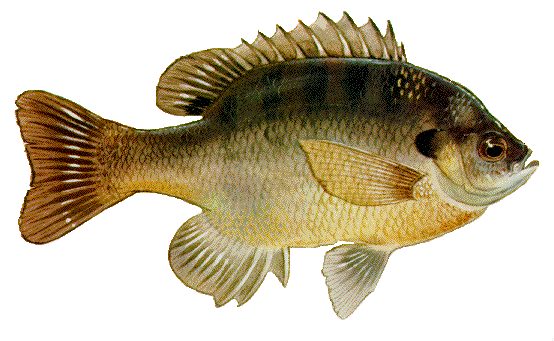Boat Away from It All
Fish In Bass Lake & Fishing Tips!
Warm Water Fish
Bass- Fall, Spring
There are lots of Spotted and some Black Bass in the lake with a good number of fish over 7 pounds caught every year. The lake record is 15.17 lbs held by Alan Bordan, a local tackle manufacturer, caught on his own swim bait in March of 2004. Most local Bass fishermen only fish in the fall and spring when the lake is quite and waves aren't stirring up the shoreline. During the summer you will find fish around the docks and holding off shore in 15' to 30' of water. Drop-shotting, jigging and finesse-fishing works best during this time of year.

Bluegill- All Year
Bluegill can be found along most of the shoreline around the lake. Kids of all ages enjoy catching them off the docks. A small spinning rod or Snoopy pole with pieces of night crawlers (earthworms), redworms, mealworms, grubs, or nymphs are all good bait for bluegill. Use a small hook, #10, and suspend the bait from a bobber. Fish the bottom in shallows and around the docks.

Crappie- Spring, Summer
A platter of fresh, flaky "white perch" is reason enough to spend a day on the water but the fishing is a reward in itself. The slower pace of dabbling jigs is a return to the kick-back days of summer vacation. A spinning rod loaded with six-pound line and a suitable spinner or jig is a productive way to fish for Crappie.
Catfish- All Year
Cats hold in big holes by day and move onto the flats above them and across from them by night. Anglers generally will do best by venturing out after hours and fishing flats with cut or stink baits. Catfish up to 22 pounds have been caught in Bass Lake.

Carp- Summer
Carp can be found in the top 5 feet of water roaming in schools. While carp may not be the greatest eating fish, they are truly great fighters. The carp in Bass Lake average around 6 pounds. The best baits by far are sweet corn and simple bread dough. The bread dough is made by moistening a few slices of any kind of bread with water and kneading it until it becomes the right texture to put on a hook. Always fish with some slack in your line and watch for any movement in the line. It is imperative that you have slack in the line because if the fish feels even the slightest resistance it will immediately drop the bait.


Cold Water Fish


Rainbow Trout- Winter, Spring
The Department of Fish & Game plants Rainbow trout every other week from mid November through April pending water temp and other conditions. Most Rainbow fishing is done during the spring to early summer, then the water gets too warm and drives the remainder of the trout to deeper water or the creek areas with cool oxygenated water feeding in the lake. The first weekend in May the Bass Lake Chamber of Commerce hosts one of California's highest possible payout trout derbies totaling $55,000. A chance of catching a $25,000 Tagged fish brings out men, women and children of all ages to enjoy a day or two of fishing on Bass Lake. Rainbows average 12 to 16 inches with some hold over trout going 16-22 inches caught each year. Fishing from shore by the Sheriff’s tower, day use areas, the Falls, Brown’s ditch and by the dam with floating bait or night-crawlers can produce limits in the winter to early summer. Boat anglers will pull a wide variety of lures tipped with night-crawlers behind a dodger and trolls in the top 20 feet of water. Once summer sets in and the lake temp goes up the fish go deeper for 58 degree and below water.
Kokanee Salmon- Spring, Winter
Kokanee takes the spotlight from June until mid September when the lake is busy with boaters of all kinds. Kokanee Salmon are known as one of the best tasting inland fish in the world. Kokanee Salmon a subspecies of Sockeye Salmon, evolved naturally after having been land locked thousands of years ago. Salmon planted each year in May as fingerlings to hopefully grow for three years before maturing. Kokanee do spawn in the lake but there is no documented survival, therefore, the lake relies on the DFG San Joaquin hatchery's annual planting. Bass Lake is rich with the Kokanee's natural food source: zoo plankton. Two year old fish, often referred to as juveniles or shakers, range from 9-13 inches and are released to protect the next year’s harvest.

